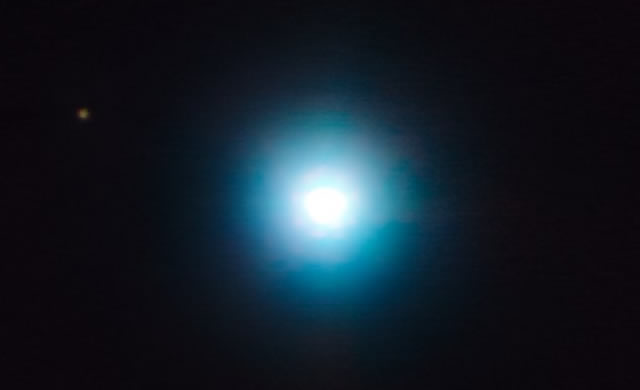
Crediti: ESO/Schmidt et al.
Gli astronomi sono a caccia di pianeti in orbita attorno ad altre stelle (esopianeti) impiegando una serie di metodi. Un metodo di successo è il rilevamento diretto; esso è particolarmente efficiente per pianeti su larghe orbite attorno a giovani stelle, poiché la luce riflessa dal pianeta non è sopraffatta dalla luce della stella ospite e quindi esso è più facile da individuare. Questa immagine dimostra questa tecnica.
Essa mostra una stella T-Tauri chiamata CVSO 30, situata approssimativamente a 1200 anni-luce dalla Terra nel gruppo 25 Orionis (appena a nord ovest della famosa cintura di Orione. Nel 2012 gli astronomi hanno trovato che CVSO 30 ospita un esopianeta (CVSO 30b) usando la tecnica conosciuta come transito, che sfrutta il fatto che la luce osservata della stella diminuisce mentre il pianeta viaggia davanti ad essa. Ora gli astronomi sono tornati a osservare questo sistema usando una serie di telescopi. Lo studio combina osservazioni ottenute con il Very Large Telescope (VLT) di ESO in Cile, il W. M. Keck Observatory alle Hawaii, e il Calar Alto Observatory in Spagna. Con questi dati gli astronomi hanno fotografato quello che sembra un secondo pianeta! Per produrre quest’immagine, gli astronomi hanno sfruttato l’astrometria fornita dagli strumenti del VLT NACO e SINFONI. Questo nuovo esopianeta, chiamato CVSO 30c, è il piccolo punto in alto a sinistra dell’immagine (la grossa macchia è la stella stessa). Mentre il pianeta conosciuta in precedenza, CVSO 30b, orbita molto vicino alla stella, con un periodo di rotazione di solo 11 ore e una distanza di 0,008 UA, CVSO 30c orbita significativamente più lontano, ad una distanza di 660 UA, impiegando un tempo sconvolgente di 27000 anni per compiere una sola orbita completa.
(Per riferimento, il pianeta Mercurio orbita attorno al Sole ad una distanza media di 0,39 UA, mentre Nettuno si trova appena oltre 30 UA.) Se fosse confermato che CVSO 30c orbita intorno a CVSO 30, questo sarebbe il primo sistema stellare che ospita contemporaneamente un pianeta vicinissimo, svelato con il metodo del transito e un pianeta lontano, svelato dal rilevamento diretto. Gli astronomi stano ancora esplorando come un tale sistema così esotico abbia potuto formarsi in così poco tempo, perché la stella ha solo 2,5 milioni di anni; è possibile che i due pianeti abbiano interagito ad un certo punto nel passato, alterando vicendevolmente le proprie traiettorie e stabilizzandosi nelle loro orbite estreme.
Astronomers hunt for planets orbiting other stars (exoplanets) using a variety of methods. One successful method is direct imaging; this is particularly effective for planets on wide orbits around young stars, because the light from the planet is not overwhelmed by light from the host star and is thus easier to spot. This image demonstrates this technique.
It shows a T-Tauri star named CVSO 30, located approximately 1200 light-years away from Earth in the 25 Orionis group (slightly northwest of Orion’s famous Belt). In 2012, astronomers found that CVSO 30 hosted one exoplanet (CVSO 30b) using a detection method known as transit photometry, where the light from a star observably dips as a planet travels in front of it. Now, astronomers have gone back to look at the system using a number of telescopes. The study combines observations obtained with the ESO’s Very Large Telescope (VLT) in Chile, the W. M. Keck Observatory in Hawaii, and the Calar Alto Observatory facilities in Spain. Using the data astronomers have imaged what is likely to be a second planet! To produce the image, astronomers exploited the astrometry provided by VLT’s NACO and SINFONI instruments. This new exoplanet, named CVSO 30c, is the small dot to the upper left of the frame (the large blob is the star itself). While the previously-detected planet, CVSO 30b, orbits very close to the star, whirling around CVSO 30 in just under 11 hours at an orbital distance of 0.008 au, CVSO 30c orbits significantly further out, at a distance of 660 au, taking a staggering 27 000 years to complete a single orbit.
(For reference, the planet Mercury orbits the Sun at an average distance of 0.39 au, while Neptune sits at just over 30 au.) If it is confirmed that CVSO 30c orbits CVSO 30, this would be the first star system to host both a close-in exoplanet detected by the transit method and a far-out exoplanet detected by direct imaging. Astronomers are still exploring how such an exotic system came to form in such a short timeframe, as the star is only 2.5 million years old; it is possible that the two planets interacted at some point in the past, scattering off one another and settling in their current extreme orbits.
Source/Continue reading → ESO.org






















